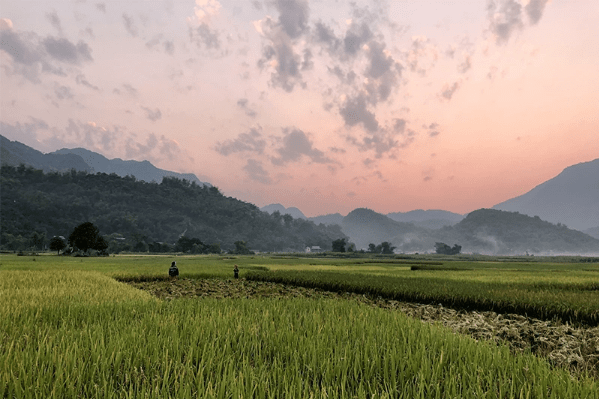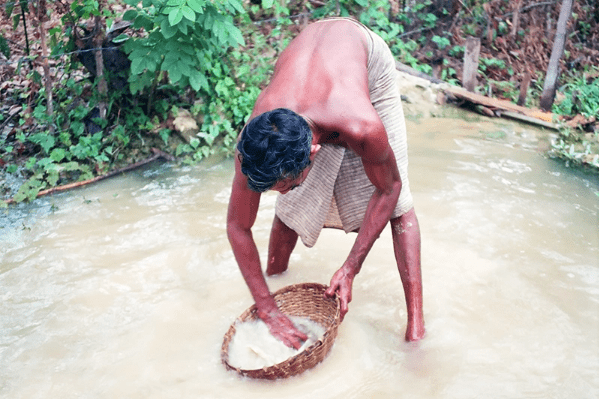From Earth to Market
Picture Vietnam’s countryside, with its lush landscapes, rolling rice terraces, and abundant water. You might not automatically associate this image with gemstones. Yet here, local farmers help support themselves by working in small-scale operations to do much of the gemstone mining in the area. They combine farming and mining in a natural rhythm.
landscapes, rolling rice terraces, and abundant water. You might not automatically associate this image with gemstones. Yet here, local farmers help support themselves by working in small-scale operations to do much of the gemstone mining in the area. They combine farming and mining in a natural rhythm.
They situate themselves along the banks of streams and rivers and wait for alluvial deposits of Spinel to get carried downstream where it can easily be found. They scoop the gravel, sort through it, and dump what they don’t need back into the river – where it helps dislodge additional deposits for the lucky souls waiting further downstream. It’s a process that continues to give sustainably and ethically because it doesn’t hurt the earth.
Transparency and Origin
 Gemstones are mined in so many countries and pass through so many hands to reach markets, knowing a stone’s origin has proved challenging. But times have changed. We can start by providing known origin whenever possible.
Gemstones are mined in so many countries and pass through so many hands to reach markets, knowing a stone’s origin has proved challenging. But times have changed. We can start by providing known origin whenever possible.
Explaining the traditional methods used in gemstone mining and how they differ from the image most people have of large, open-pit mines can aid in your sale. Gemstone sustainability isn’t a recent development. For thousands of years, most gemstones have emerged from the earth through a variety of small mining endeavors. They leave a minimal environmental footprint while helping families and communities improve their way of life.
Traditional gemstone mining
Two hundred varieties of known gemstones grow in fascinating ways all around the globe. And each of these locations requires a different type of mining. Some gems are found in riverbeds as in Vietnam, while others are hidden in holes, measuring just three feet wide and six feet deep. Some come from immense caves on mountainsides and cliffs, while others emerge from top-mined plots, similar to the sod farms that dot North America.
grow in fascinating ways all around the globe. And each of these locations requires a different type of mining. Some gems are found in riverbeds as in Vietnam, while others are hidden in holes, measuring just three feet wide and six feet deep. Some come from immense caves on mountainsides and cliffs, while others emerge from top-mined plots, similar to the sod farms that dot North America.
Spinel and Garnet are common in river panning – just like gold once was. Sapphires are most often found deeper in the earth, so uncovering them requires some digging. Minerals in the beryl family most commonly form in heavy, dense rock areas (e.g., mountainsides), where the terrain tends to be as dangerous as the animals inhabiting it.
 Gemstone miners are acutely aware of their surroundings and as such, can determine a mineral’s growth pattern, vein structure (i.e., spread out rather than straight down), and resilience. They don’t need heavy equipment, large transport vehicles, or miles-wide holes. Instead, a hand-woven panning basket, a shovel, and (if you can afford one) a water pump encompass the necessary equipment.
Gemstone miners are acutely aware of their surroundings and as such, can determine a mineral’s growth pattern, vein structure (i.e., spread out rather than straight down), and resilience. They don’t need heavy equipment, large transport vehicles, or miles-wide holes. Instead, a hand-woven panning basket, a shovel, and (if you can afford one) a water pump encompass the necessary equipment.
Know the story behind each gemstone
If you’re armed with the knowledge of these differences of each stone sourced, you can feel confident in their origin and ready to answer any questions your admirers may have. The materials and design of your purchases mean something more than meets the eye.
differences of each stone sourced, you can feel confident in their origin and ready to answer any questions your admirers may have. The materials and design of your purchases mean something more than meets the eye.
